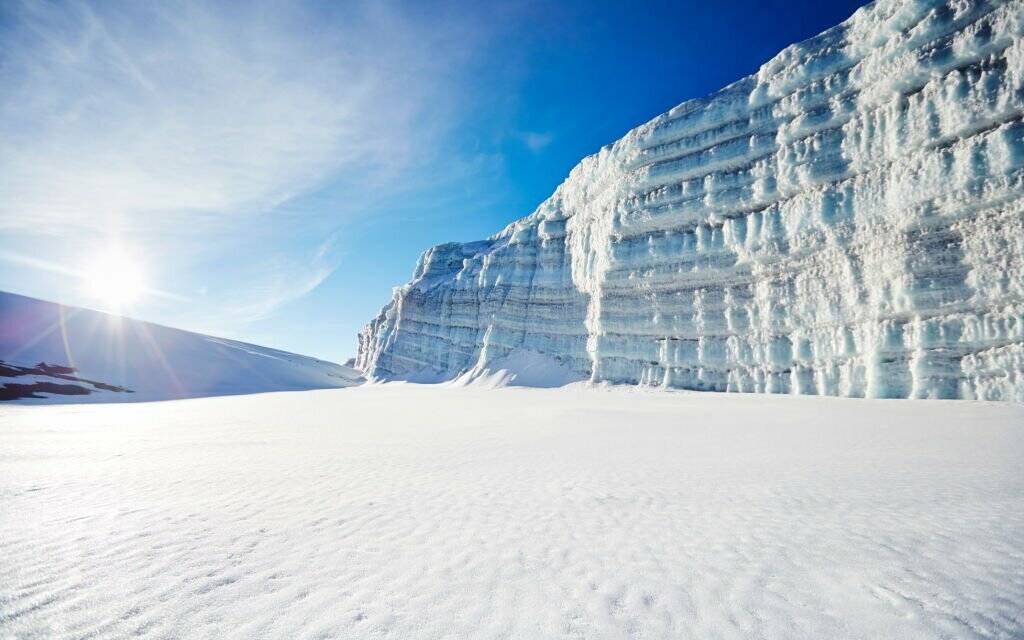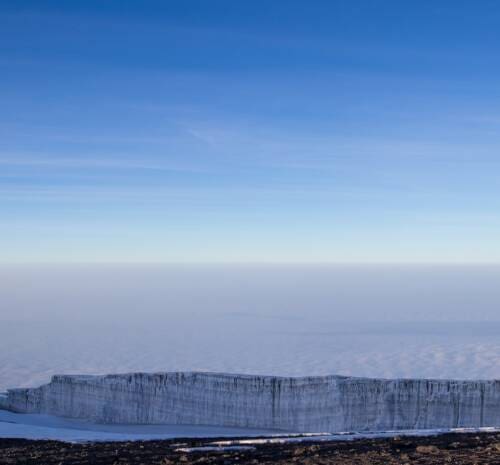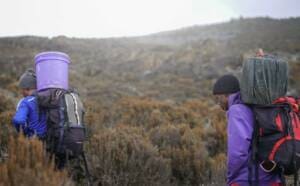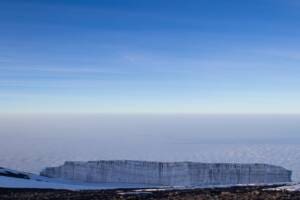Introduction to Kilimanjaro Glaciers
Kilimanjaro Glaciers, a majestic mountain in Tanzania, is famous not only for its towering peaks and breathtaking views but also for its mysterious glacier. Despite the intense equatorial sun, these glaciers have managed to survive by reflecting most of the heat and preserving their ice charm. However, their presence is never stable, but serves as a dynamic reminder of both climate history and possible natural disasters. This article delves into the fascinating history of the Kilimanjaro Glaciers, exploring its formation, current condition, and challenges it faces.
A Geological Wonder
The Formation of Kilimanjaro Glaciers
Kilimanjaro glaciers owe their existence to the unique geological features of the mountain. The process began approximately 11,700 years ago, during the last ice age, when the climate was colder and more conducive to glacial formation. As temperatures dropped, snowfall accumulated on the mountain`s peaks, eventually compacting into ice. Over time, these frozen masses transformed into the glaciers we see today.
The Fragile Balance: Ice vs. Heat
Despite its amazing resilience, Kilimanjaro Glaciers faces a constant battle with the unrelenting equatorial sun. Although the sun’s rays are intense, most of them are reflected by the glistening white surface of the ice. But the black lava beneath the glacier absorbs heat, causing the ice to melt from below. This continuous melting process creates instability, causing overhangs and cracks within the glacier.
Glaciers as Climate Archives
Kilimanjaro glaciers serve as a valuable record of climate history and provide insight into past environmental conditions.
Researchers were able to examine ice cores extracted from glaciers and analyze the air bubbles and isotopes trapped within them.
These analyses provide insight into past temperature fluctuations, the composition of the atmosphere, and even the presence of volcanic eruptions. Understanding the past allows scientists to better understand the present and make predictions about the future.
Key facts about Kilimanjaro Glaciers
Estimated age of glaciers: 11,700 years old.
Based on research on the ice fields north of Kilimanjaro, the glacier is probably 11,700 years old. However, in some areas where exposure to weather and solar radiation has likely caused thawing and refreezing, the tree is estimated to be 800 years old.
Furtwangler Glacier has been shrinking rapidly:
- size in 1976: 113,000 square metres (1,220,000 sq ft)
- size in 2000: 11,000 square metres (120,000 sq ft)
Mapping of the Kilimanjaro ice sheet has been recorded since the early 20th century. It turns out that more than 80% of Kilimanjaro entire ice has already disappeared since 1912. By 2011, an estimated 85% of Furtwängler Glacier had melted.
Estimated date of complete loss of glaciers on Kilimanjaro: between 2030 and 2060
The peak of Mount Kilimanjaro reaches an astonishing height of 5,895 meters. Climbers who successfully reach the summit are rewarded with views of Kilimanjaro’s glaciers and ice fields.
Ice fields to the north and south protect the bases of some of these glaciers. Unfortunately, Kilimanjaro loses more and more snow each year, leaving the ice fields more and more empty, resulting in accelerated melting of the glaciers and ice fields over the years.
Some of the most notable tropical glaciers atop Kilimanjaro include:
Furtwängler Glacier
– Kilimanjaro Largest Glacier
– Estimated extinction: 2030
– Named for Walter Furtwängler, one of the climbers to successfully summit Kilimanjaro in 1912
Rebmann Glacier
– Located near the Southern Icefield
– Named for Johann Rebmann, a German missionary-explorer who was the first European to make a record of glaciers on Kilimanjaro in the year 1848.
Credner Glacier
– Located near the Northern Icefield
– One of the largest remaining glaciers on Kilimanjaro, to-date, but is rapidly disappearing. Studies conducted in association with the Smithsonian Institute have estimated extinction before the year 2030.
Arrow Glacier
-Arrow Glacier is a remnant of the former “Little Barranko Glacier” located along Kilimanjaro’s Lemosho route.
– This small surviving glacier is melting rapidly and may even be gone by the time this article is published.
This is the sad and irreversible reality of global warming.
Once a glacier completely disappears, it cannot be replaced.

The disappearance of Kilimanjaro glaciers
According to National Geographic, Kilimanjaro glaciers could disappear as early as 2030. Some more optimistic scientists predict the Furtwängler Glacier’s disappearance in 2060. But both dates are still fresh in the minds of many readers.
According to National Geographic, Kilimanjaro’s glaciers could disappear as early as 2030. Some more optimistic scientists put the Furtwängler Glacier’s disappearance in 2060. But both dates are still fresh in the minds of many readers.
Tracking
Based on ice field mapping and observation records from the peak of Mount Kilimanjaro in the early 20th century, it is clear that glaciers are disappearing rapidly when compared with current data.
Of course, the ice may have receded somewhat over the centuries, but the rate of ice loss has visibly accelerated in recent decades. Studies from the National Academy of Sciences show that Kilimanjaro’s ice area is decreasing by about a factor of one.
But from 1989 to 2007, the rate of decline doubled to an astonishing 2.5%. The worrying increase is due to the effects of climate change, which have become more pronounced in recent decades.
According to NASA, the Earth Observatory’s official page, where experts can view satellite images of various locations around the world, including Mount Kilimanjaro, states: “Between 1912 and 2011, the ice mass at the summit decreased by more than 85%.
“The question is no longer if the ice will disappear, but when”
“It’s no longer a question of whether the ice will disappear but when.” – NASA Earth Observatory
Another aerial study of Kilimanjaro concluded that “all ice bodies on Kilimanjaro have declined significantly between 1912 and 2003.
” Since this data is more than 10 years old, we can conclude that the Kilimanjaro ice field and surrounding tropical glaciers have declined by more than 90%.
Main reasons
Tropical glaciers like Furtwängler Glacier are an anomaly. The high altitude of mountaintop glaciers accounts for the presence of snow and ice, but the strong equatorial sunlight and relatively stable tropical climate make tropical glaciers vulnerable to natural elements.
However, Kilimanjaro glaciers have been protected by ice fields and snow for more than 10,000 years. It is only in recent decades that we have seen a significant decline in ice fields and the complete disappearance of some glaciers.
Although we talk about the “melting” of glaciers, the actual process of ice loss on Kilimanjaro is similar to sublimation. That is, it is a process in which ice does not slowly melt into water but rather evaporates into steam. This causes Kilimanjaro’s ice to form into clouds that transport sweat elsewhere at a later date. This effectively means that there is no possibility of the water refreezing into snow or ice, preserving the Kilimanjaro Glaciers, or slowing its disappearance.
Considering that ice loss has increased in recent decades, it is undeniable that climate change is responsible for the disappearance of Kilimanjaro Glaciers.
The Future
Unfortunately, there is no way to slow the disappearance of Kilimanjaro ice fields and glaciers. We hope this will not have a significant negative impact on tourism in Tanzania, as many local guides rely on regular tourism for their income.
However, we at Shiri Adventures hope that this reality will encourage more travel companies and large corporations to take the necessary steps to protect Tanzania’s natural beauty. While some steps have been taken to ensure that protected areas protect animals and protect Tanzania endangered elephant and rhino populations, we need to do more to protect this precious environment. You need to make an effort.
Tourists who wish to experience the beauty of Africa, view endangered animals, and physically visit some of the most remarkable places in the world (such as UNESCO Heritage Sites, Serengeti, and Ngorongoro Crater) should ensure they book with socially responsible operators who have taken steps to reduce any negative impact on the Tanzania environment. This includes operators leading Kilimanjaro treks. Africa’s highest mountain is already losing it’s important ice cover and glaciers; we do not want it to lose anything else in the future.
At Shiri Adventures, we ensure that our mountain guides are not only trained and knowledgeable about precautions and conservation but are also as passionate about protecting Tanzania’s environment as we are. Our guides love Tanzania, whether it’s their home or their newfound love. They take great care to ensure that hiking at Mt. Kilimanjaro Shiri is environmentally friendly.
We pay special attention to our camping methods, take “leave no trace” precautions, and farm sustainably and responsibly.
Ice and climbers
While ice climbing is an incredible sport, out of respect for Africa’s diminishing tropical glaciers, we do not promote ice climbing on any of Mount Kilimanjaro glaciers.
Recently, professional ice climber Will Gadd returned to Tanzania to climb the mountain famous Furtwängler Glacier. Gadd successfully ice-climbed Kilimanjaro largest glacier back in 2014, but when he arrived in 2020, the same glacier was noticeably smaller and the ice walls had become dangerously thin. Gadd abandoned his climb and instead channelled his passion for the sport into becoming an advocate for climate change with the United Nations.
Instead of ice-climbing Kilimanjaro glaciers, we encourage visitors to trek Mount Kilimanjaro and see the disappearing glaciers first-hand before they melt away completely. Climbing teams can take photos of these soon-to-be-extinct aspects of nature with an environmentally friendly Shiri Kilimanjaro climb.
During your trek, you can walk on or stand beside some of the surviving glaciers found on Kilimanjaro. This activity should not increase the melting of the glacier if you are careful and do not intentionally cut at or chip away any part of the ice.
Preserving Kilimanjaro Glaciers
The Role of Climate Change
While the melting of Kilimanjaro’s glaciers is influenced by natural processes, the impact of human-induced climate change cannot be understated. Rising global temperatures exacerbate the effects of solar radiation, accelerating glacial melting. The reduction of greenhouse gas emissions and proactive climate change mitigation strategies are vital to preserving not only Kilimanjaro glaciers but also the world’s fragile ice formations.
Sustainable Tourism and Conservation Efforts
Preserving Kilimanjaro glaciers requires a collaborative effort involving local communities, government agencies, and the tourism industry. Sustainable tourism practices can help minimize the ecological footprint of climbers and promote responsible exploration. Conservation initiatives, such as reforestation projects and watershed management, can contribute to the overall preservation of Kilimanjaro’s delicate ecosystem.
Conclusion
Kilimanjaro glaciers are not just frozen wonders but living witnesses to the Earth’s climatic history. As these icy giants face the threat of melting, it is imperative that we appreciate their significance and take action to protect them. By understanding the geological processes, the implications of glacial melting, and the role of climate change, we can work towards a sustainable future for Kilimanjaro’s glaciers and ensure that future generations can marvel at their beauty.






